Leadership Theories and Styles: Impact on Employee Performance
VerifiedAdded on 2021/01/02
|11
|3912
|406
Report
AI Summary
This report provides a comprehensive overview of various leadership theories, including Great Man Theory, Situational Theory, Contingency Theory, Trait Theory, Behavioral Theory, Participative Theory, Transformational Theories, and Transactional Leadership Theory. It explores different leadership styles such as Democratic, Autocratic, and Strategic leadership. The report analyzes the positive effects of effective leadership styles on employee performance, emphasizing the importance of leadership in motivating teams and achieving organizational goals. It also highlights the impact of leadership on business growth and offers practical examples of how different leadership approaches can be implemented. The report concludes by discussing the importance of selecting the most effective leadership theory for a fast-growing firm, underscoring the critical role of leadership in driving organizational success. The report is designed to help students understand leadership concepts and how they can be applied in real-world business scenarios.
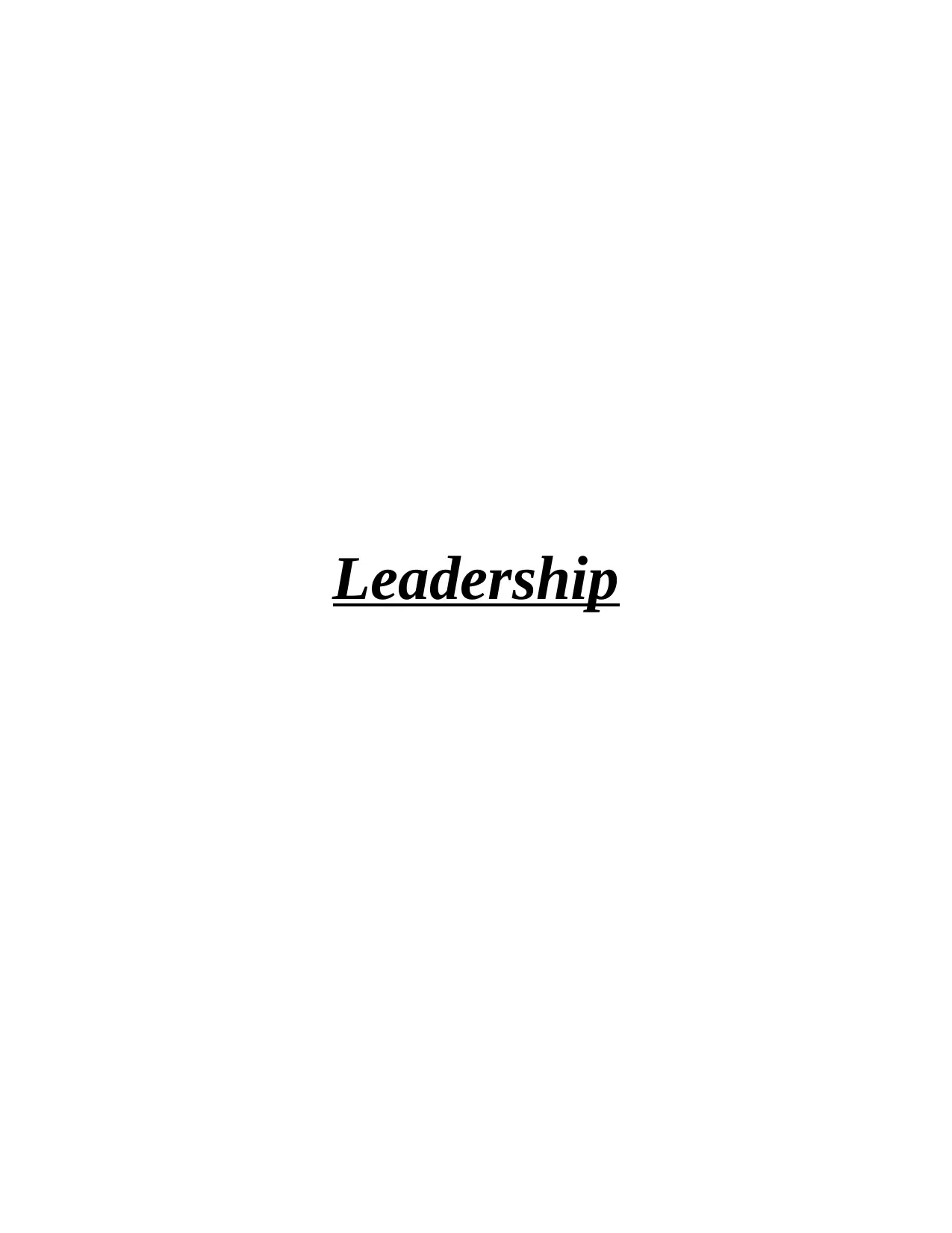
Leadership
Paraphrase This Document
Need a fresh take? Get an instant paraphrase of this document with our AI Paraphraser
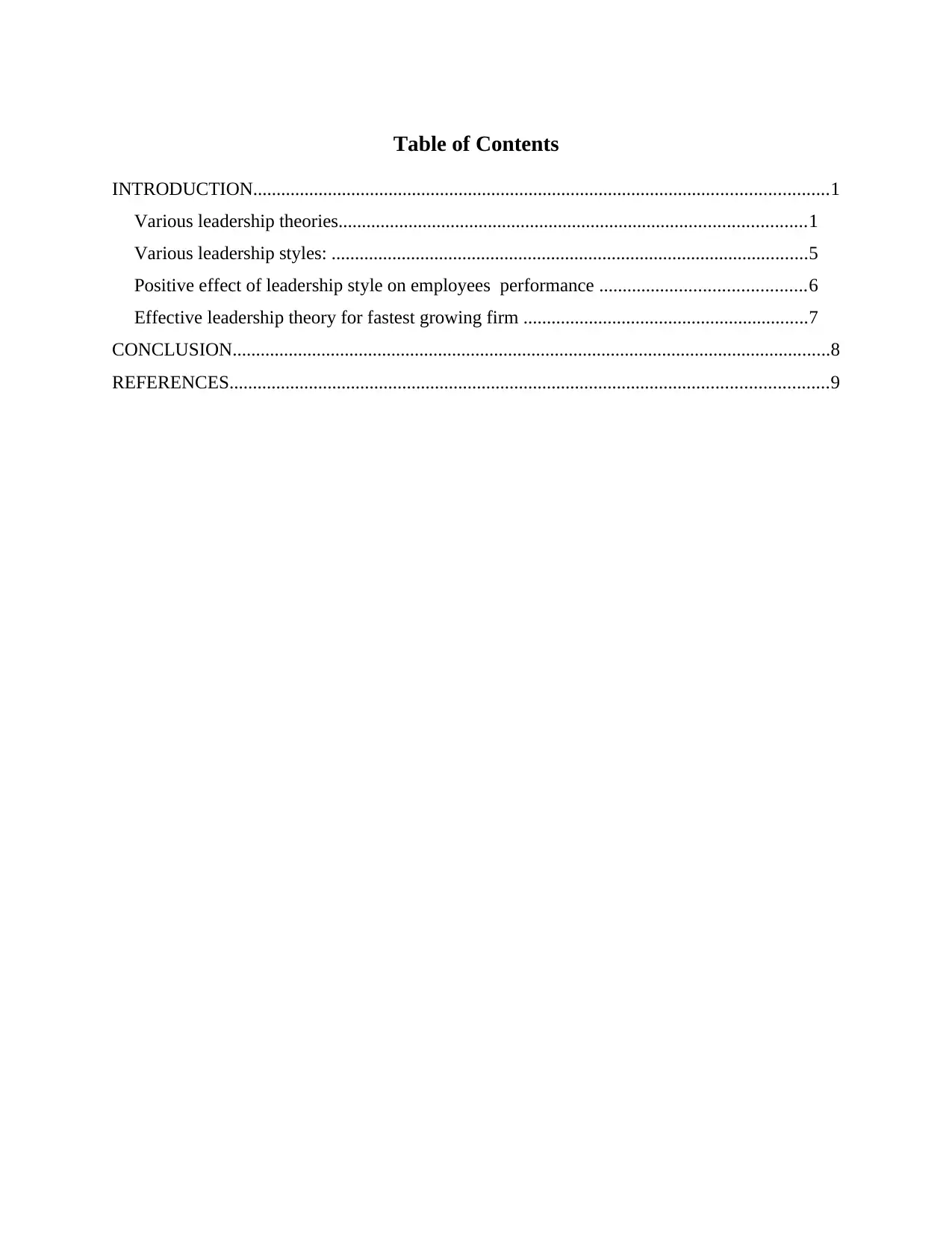
Table of Contents
INTRODUCTION...........................................................................................................................1
Various leadership theories....................................................................................................1
Various leadership styles: ......................................................................................................5
Positive effect of leadership style on employees performance ............................................6
Effective leadership theory for fastest growing firm .............................................................7
CONCLUSION................................................................................................................................8
REFERENCES................................................................................................................................9
INTRODUCTION...........................................................................................................................1
Various leadership theories....................................................................................................1
Various leadership styles: ......................................................................................................5
Positive effect of leadership style on employees performance ............................................6
Effective leadership theory for fastest growing firm .............................................................7
CONCLUSION................................................................................................................................8
REFERENCES................................................................................................................................9
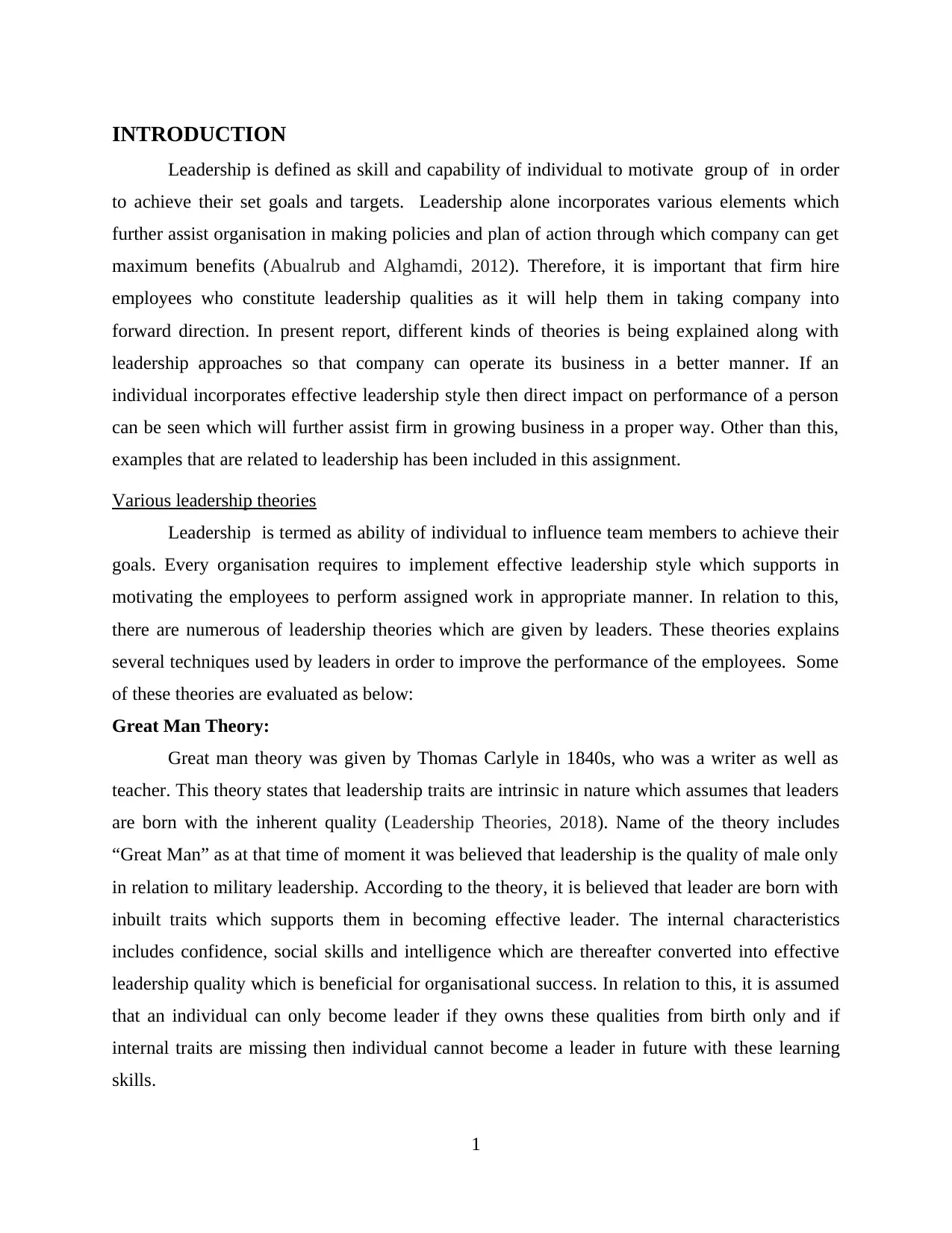
INTRODUCTION
Leadership is defined as skill and capability of individual to motivate group of in order
to achieve their set goals and targets. Leadership alone incorporates various elements which
further assist organisation in making policies and plan of action through which company can get
maximum benefits (Abualrub and Alghamdi, 2012). Therefore, it is important that firm hire
employees who constitute leadership qualities as it will help them in taking company into
forward direction. In present report, different kinds of theories is being explained along with
leadership approaches so that company can operate its business in a better manner. If an
individual incorporates effective leadership style then direct impact on performance of a person
can be seen which will further assist firm in growing business in a proper way. Other than this,
examples that are related to leadership has been included in this assignment.
Various leadership theories
Leadership is termed as ability of individual to influence team members to achieve their
goals. Every organisation requires to implement effective leadership style which supports in
motivating the employees to perform assigned work in appropriate manner. In relation to this,
there are numerous of leadership theories which are given by leaders. These theories explains
several techniques used by leaders in order to improve the performance of the employees. Some
of these theories are evaluated as below:
Great Man Theory:
Great man theory was given by Thomas Carlyle in 1840s, who was a writer as well as
teacher. This theory states that leadership traits are intrinsic in nature which assumes that leaders
are born with the inherent quality (Leadership Theories, 2018). Name of the theory includes
“Great Man” as at that time of moment it was believed that leadership is the quality of male only
in relation to military leadership. According to the theory, it is believed that leader are born with
inbuilt traits which supports them in becoming effective leader. The internal characteristics
includes confidence, social skills and intelligence which are thereafter converted into effective
leadership quality which is beneficial for organisational success. In relation to this, it is assumed
that an individual can only become leader if they owns these qualities from birth only and if
internal traits are missing then individual cannot become a leader in future with these learning
skills.
1
Leadership is defined as skill and capability of individual to motivate group of in order
to achieve their set goals and targets. Leadership alone incorporates various elements which
further assist organisation in making policies and plan of action through which company can get
maximum benefits (Abualrub and Alghamdi, 2012). Therefore, it is important that firm hire
employees who constitute leadership qualities as it will help them in taking company into
forward direction. In present report, different kinds of theories is being explained along with
leadership approaches so that company can operate its business in a better manner. If an
individual incorporates effective leadership style then direct impact on performance of a person
can be seen which will further assist firm in growing business in a proper way. Other than this,
examples that are related to leadership has been included in this assignment.
Various leadership theories
Leadership is termed as ability of individual to influence team members to achieve their
goals. Every organisation requires to implement effective leadership style which supports in
motivating the employees to perform assigned work in appropriate manner. In relation to this,
there are numerous of leadership theories which are given by leaders. These theories explains
several techniques used by leaders in order to improve the performance of the employees. Some
of these theories are evaluated as below:
Great Man Theory:
Great man theory was given by Thomas Carlyle in 1840s, who was a writer as well as
teacher. This theory states that leadership traits are intrinsic in nature which assumes that leaders
are born with the inherent quality (Leadership Theories, 2018). Name of the theory includes
“Great Man” as at that time of moment it was believed that leadership is the quality of male only
in relation to military leadership. According to the theory, it is believed that leader are born with
inbuilt traits which supports them in becoming effective leader. The internal characteristics
includes confidence, social skills and intelligence which are thereafter converted into effective
leadership quality which is beneficial for organisational success. In relation to this, it is assumed
that an individual can only become leader if they owns these qualities from birth only and if
internal traits are missing then individual cannot become a leader in future with these learning
skills.
1
⊘ This is a preview!⊘
Do you want full access?
Subscribe today to unlock all pages.

Trusted by 1+ million students worldwide
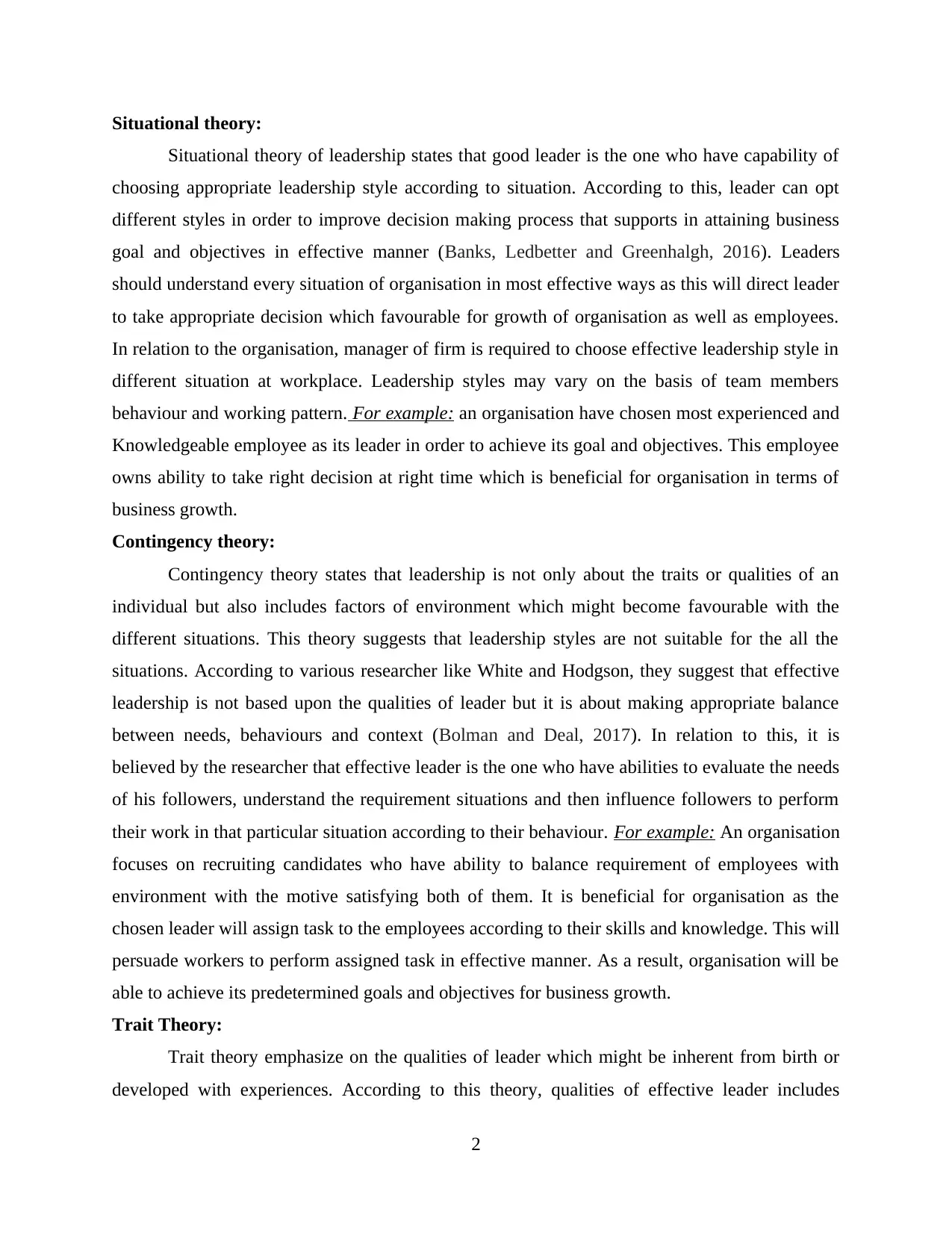
Situational theory:
Situational theory of leadership states that good leader is the one who have capability of
choosing appropriate leadership style according to situation. According to this, leader can opt
different styles in order to improve decision making process that supports in attaining business
goal and objectives in effective manner (Banks, Ledbetter and Greenhalgh, 2016). Leaders
should understand every situation of organisation in most effective ways as this will direct leader
to take appropriate decision which favourable for growth of organisation as well as employees.
In relation to the organisation, manager of firm is required to choose effective leadership style in
different situation at workplace. Leadership styles may vary on the basis of team members
behaviour and working pattern. For example: an organisation have chosen most experienced and
Knowledgeable employee as its leader in order to achieve its goal and objectives. This employee
owns ability to take right decision at right time which is beneficial for organisation in terms of
business growth.
Contingency theory:
Contingency theory states that leadership is not only about the traits or qualities of an
individual but also includes factors of environment which might become favourable with the
different situations. This theory suggests that leadership styles are not suitable for the all the
situations. According to various researcher like White and Hodgson, they suggest that effective
leadership is not based upon the qualities of leader but it is about making appropriate balance
between needs, behaviours and context (Bolman and Deal, 2017). In relation to this, it is
believed by the researcher that effective leader is the one who have abilities to evaluate the needs
of his followers, understand the requirement situations and then influence followers to perform
their work in that particular situation according to their behaviour. For example: An organisation
focuses on recruiting candidates who have ability to balance requirement of employees with
environment with the motive satisfying both of them. It is beneficial for organisation as the
chosen leader will assign task to the employees according to their skills and knowledge. This will
persuade workers to perform assigned task in effective manner. As a result, organisation will be
able to achieve its predetermined goals and objectives for business growth.
Trait Theory:
Trait theory emphasize on the qualities of leader which might be inherent from birth or
developed with experiences. According to this theory, qualities of effective leader includes
2
Situational theory of leadership states that good leader is the one who have capability of
choosing appropriate leadership style according to situation. According to this, leader can opt
different styles in order to improve decision making process that supports in attaining business
goal and objectives in effective manner (Banks, Ledbetter and Greenhalgh, 2016). Leaders
should understand every situation of organisation in most effective ways as this will direct leader
to take appropriate decision which favourable for growth of organisation as well as employees.
In relation to the organisation, manager of firm is required to choose effective leadership style in
different situation at workplace. Leadership styles may vary on the basis of team members
behaviour and working pattern. For example: an organisation have chosen most experienced and
Knowledgeable employee as its leader in order to achieve its goal and objectives. This employee
owns ability to take right decision at right time which is beneficial for organisation in terms of
business growth.
Contingency theory:
Contingency theory states that leadership is not only about the traits or qualities of an
individual but also includes factors of environment which might become favourable with the
different situations. This theory suggests that leadership styles are not suitable for the all the
situations. According to various researcher like White and Hodgson, they suggest that effective
leadership is not based upon the qualities of leader but it is about making appropriate balance
between needs, behaviours and context (Bolman and Deal, 2017). In relation to this, it is
believed by the researcher that effective leader is the one who have abilities to evaluate the needs
of his followers, understand the requirement situations and then influence followers to perform
their work in that particular situation according to their behaviour. For example: An organisation
focuses on recruiting candidates who have ability to balance requirement of employees with
environment with the motive satisfying both of them. It is beneficial for organisation as the
chosen leader will assign task to the employees according to their skills and knowledge. This will
persuade workers to perform assigned task in effective manner. As a result, organisation will be
able to achieve its predetermined goals and objectives for business growth.
Trait Theory:
Trait theory emphasize on the qualities of leader which might be inherent from birth or
developed with experiences. According to this theory, qualities of effective leader includes
2
Paraphrase This Document
Need a fresh take? Get an instant paraphrase of this document with our AI Paraphraser
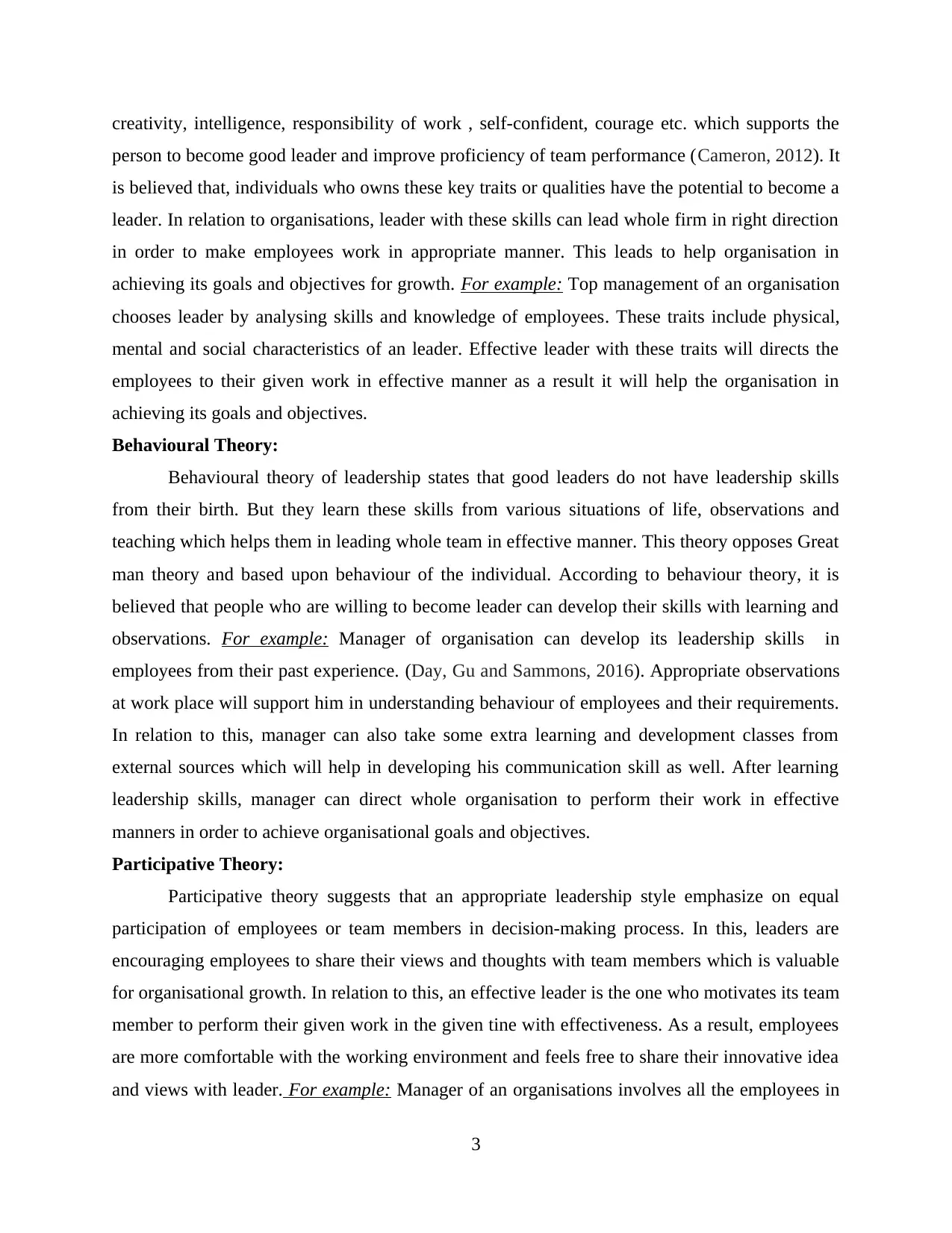
creativity, intelligence, responsibility of work , self-confident, courage etc. which supports the
person to become good leader and improve proficiency of team performance (Cameron, 2012). It
is believed that, individuals who owns these key traits or qualities have the potential to become a
leader. In relation to organisations, leader with these skills can lead whole firm in right direction
in order to make employees work in appropriate manner. This leads to help organisation in
achieving its goals and objectives for growth. For example: Top management of an organisation
chooses leader by analysing skills and knowledge of employees. These traits include physical,
mental and social characteristics of an leader. Effective leader with these traits will directs the
employees to their given work in effective manner as a result it will help the organisation in
achieving its goals and objectives.
Behavioural Theory:
Behavioural theory of leadership states that good leaders do not have leadership skills
from their birth. But they learn these skills from various situations of life, observations and
teaching which helps them in leading whole team in effective manner. This theory opposes Great
man theory and based upon behaviour of the individual. According to behaviour theory, it is
believed that people who are willing to become leader can develop their skills with learning and
observations. For example: Manager of organisation can develop its leadership skills in
employees from their past experience. (Day, Gu and Sammons, 2016). Appropriate observations
at work place will support him in understanding behaviour of employees and their requirements.
In relation to this, manager can also take some extra learning and development classes from
external sources which will help in developing his communication skill as well. After learning
leadership skills, manager can direct whole organisation to perform their work in effective
manners in order to achieve organisational goals and objectives.
Participative Theory:
Participative theory suggests that an appropriate leadership style emphasize on equal
participation of employees or team members in decision-making process. In this, leaders are
encouraging employees to share their views and thoughts with team members which is valuable
for organisational growth. In relation to this, an effective leader is the one who motivates its team
member to perform their given work in the given tine with effectiveness. As a result, employees
are more comfortable with the working environment and feels free to share their innovative idea
and views with leader. For example: Manager of an organisations involves all the employees in
3
person to become good leader and improve proficiency of team performance (Cameron, 2012). It
is believed that, individuals who owns these key traits or qualities have the potential to become a
leader. In relation to organisations, leader with these skills can lead whole firm in right direction
in order to make employees work in appropriate manner. This leads to help organisation in
achieving its goals and objectives for growth. For example: Top management of an organisation
chooses leader by analysing skills and knowledge of employees. These traits include physical,
mental and social characteristics of an leader. Effective leader with these traits will directs the
employees to their given work in effective manner as a result it will help the organisation in
achieving its goals and objectives.
Behavioural Theory:
Behavioural theory of leadership states that good leaders do not have leadership skills
from their birth. But they learn these skills from various situations of life, observations and
teaching which helps them in leading whole team in effective manner. This theory opposes Great
man theory and based upon behaviour of the individual. According to behaviour theory, it is
believed that people who are willing to become leader can develop their skills with learning and
observations. For example: Manager of organisation can develop its leadership skills in
employees from their past experience. (Day, Gu and Sammons, 2016). Appropriate observations
at work place will support him in understanding behaviour of employees and their requirements.
In relation to this, manager can also take some extra learning and development classes from
external sources which will help in developing his communication skill as well. After learning
leadership skills, manager can direct whole organisation to perform their work in effective
manners in order to achieve organisational goals and objectives.
Participative Theory:
Participative theory suggests that an appropriate leadership style emphasize on equal
participation of employees or team members in decision-making process. In this, leaders are
encouraging employees to share their views and thoughts with team members which is valuable
for organisational growth. In relation to this, an effective leader is the one who motivates its team
member to perform their given work in the given tine with effectiveness. As a result, employees
are more comfortable with the working environment and feels free to share their innovative idea
and views with leader. For example: Manager of an organisations involves all the employees in
3
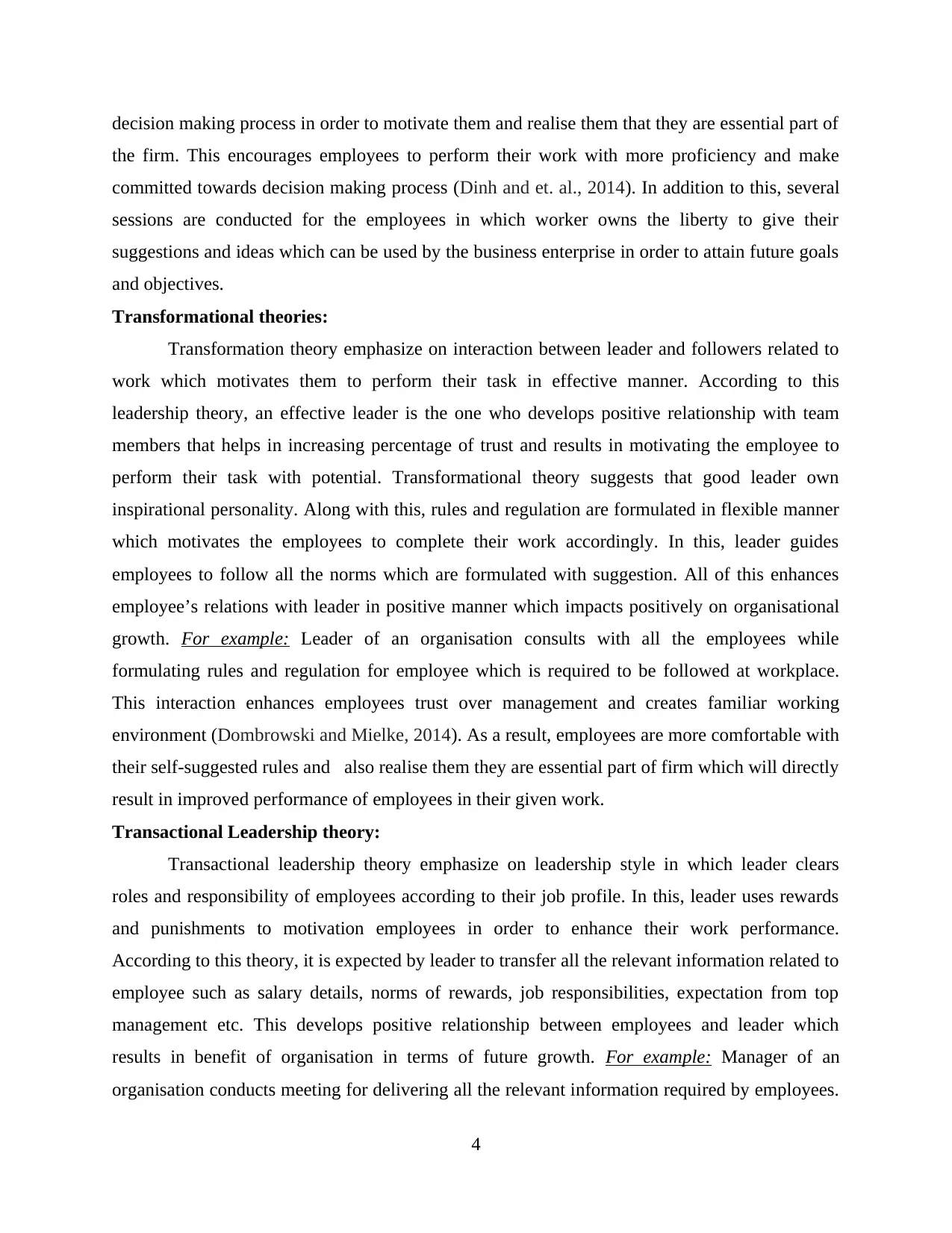
decision making process in order to motivate them and realise them that they are essential part of
the firm. This encourages employees to perform their work with more proficiency and make
committed towards decision making process (Dinh and et. al., 2014). In addition to this, several
sessions are conducted for the employees in which worker owns the liberty to give their
suggestions and ideas which can be used by the business enterprise in order to attain future goals
and objectives.
Transformational theories:
Transformation theory emphasize on interaction between leader and followers related to
work which motivates them to perform their task in effective manner. According to this
leadership theory, an effective leader is the one who develops positive relationship with team
members that helps in increasing percentage of trust and results in motivating the employee to
perform their task with potential. Transformational theory suggests that good leader own
inspirational personality. Along with this, rules and regulation are formulated in flexible manner
which motivates the employees to complete their work accordingly. In this, leader guides
employees to follow all the norms which are formulated with suggestion. All of this enhances
employee’s relations with leader in positive manner which impacts positively on organisational
growth. For example: Leader of an organisation consults with all the employees while
formulating rules and regulation for employee which is required to be followed at workplace.
This interaction enhances employees trust over management and creates familiar working
environment (Dombrowski and Mielke, 2014). As a result, employees are more comfortable with
their self-suggested rules and also realise them they are essential part of firm which will directly
result in improved performance of employees in their given work.
Transactional Leadership theory:
Transactional leadership theory emphasize on leadership style in which leader clears
roles and responsibility of employees according to their job profile. In this, leader uses rewards
and punishments to motivation employees in order to enhance their work performance.
According to this theory, it is expected by leader to transfer all the relevant information related to
employee such as salary details, norms of rewards, job responsibilities, expectation from top
management etc. This develops positive relationship between employees and leader which
results in benefit of organisation in terms of future growth. For example: Manager of an
organisation conducts meeting for delivering all the relevant information required by employees.
4
the firm. This encourages employees to perform their work with more proficiency and make
committed towards decision making process (Dinh and et. al., 2014). In addition to this, several
sessions are conducted for the employees in which worker owns the liberty to give their
suggestions and ideas which can be used by the business enterprise in order to attain future goals
and objectives.
Transformational theories:
Transformation theory emphasize on interaction between leader and followers related to
work which motivates them to perform their task in effective manner. According to this
leadership theory, an effective leader is the one who develops positive relationship with team
members that helps in increasing percentage of trust and results in motivating the employee to
perform their task with potential. Transformational theory suggests that good leader own
inspirational personality. Along with this, rules and regulation are formulated in flexible manner
which motivates the employees to complete their work accordingly. In this, leader guides
employees to follow all the norms which are formulated with suggestion. All of this enhances
employee’s relations with leader in positive manner which impacts positively on organisational
growth. For example: Leader of an organisation consults with all the employees while
formulating rules and regulation for employee which is required to be followed at workplace.
This interaction enhances employees trust over management and creates familiar working
environment (Dombrowski and Mielke, 2014). As a result, employees are more comfortable with
their self-suggested rules and also realise them they are essential part of firm which will directly
result in improved performance of employees in their given work.
Transactional Leadership theory:
Transactional leadership theory emphasize on leadership style in which leader clears
roles and responsibility of employees according to their job profile. In this, leader uses rewards
and punishments to motivation employees in order to enhance their work performance.
According to this theory, it is expected by leader to transfer all the relevant information related to
employee such as salary details, norms of rewards, job responsibilities, expectation from top
management etc. This develops positive relationship between employees and leader which
results in benefit of organisation in terms of future growth. For example: Manager of an
organisation conducts meeting for delivering all the relevant information required by employees.
4
⊘ This is a preview!⊘
Do you want full access?
Subscribe today to unlock all pages.

Trusted by 1+ million students worldwide
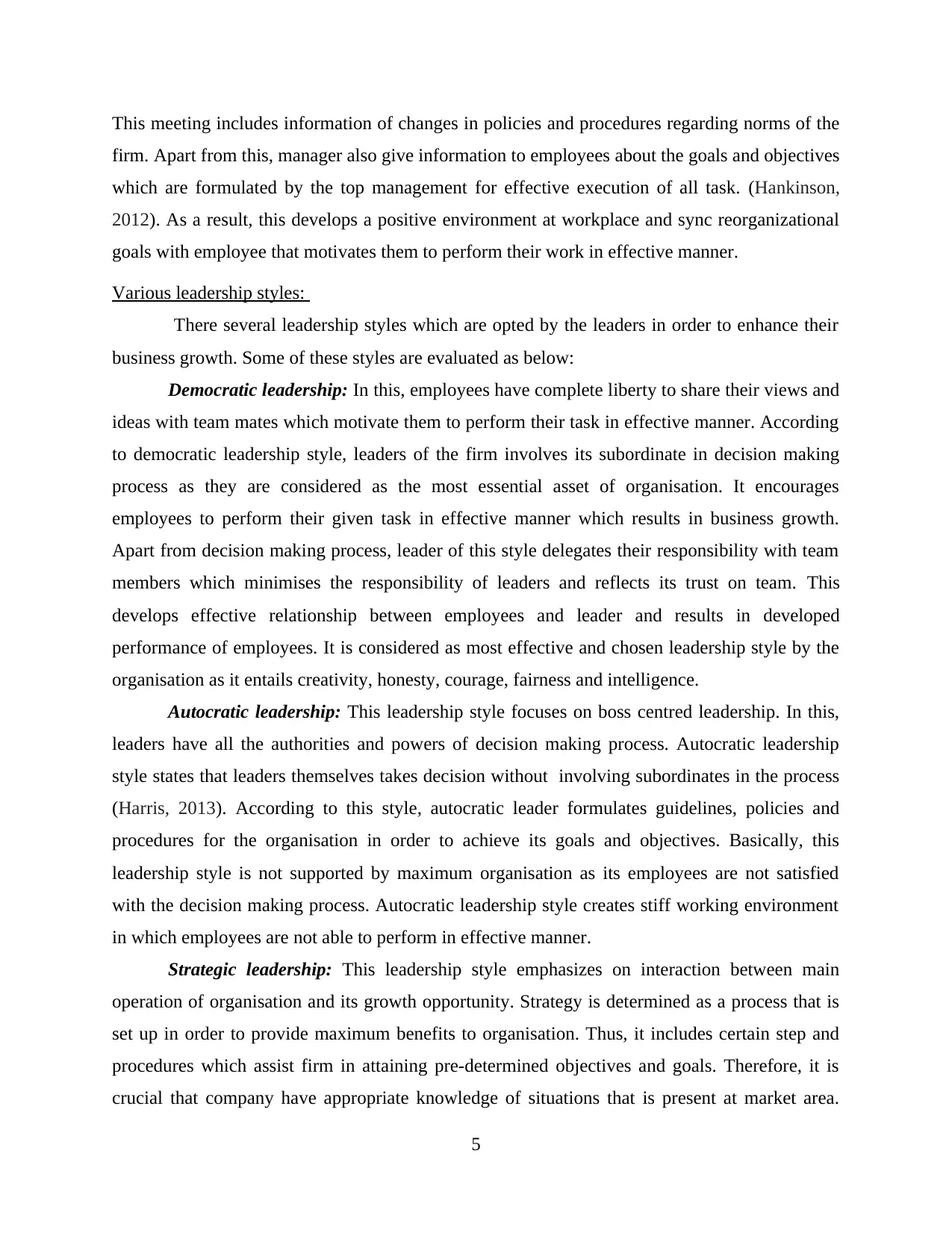
This meeting includes information of changes in policies and procedures regarding norms of the
firm. Apart from this, manager also give information to employees about the goals and objectives
which are formulated by the top management for effective execution of all task. (Hankinson,
2012). As a result, this develops a positive environment at workplace and sync reorganizational
goals with employee that motivates them to perform their work in effective manner.
Various leadership styles:
There several leadership styles which are opted by the leaders in order to enhance their
business growth. Some of these styles are evaluated as below:
Democratic leadership: In this, employees have complete liberty to share their views and
ideas with team mates which motivate them to perform their task in effective manner. According
to democratic leadership style, leaders of the firm involves its subordinate in decision making
process as they are considered as the most essential asset of organisation. It encourages
employees to perform their given task in effective manner which results in business growth.
Apart from decision making process, leader of this style delegates their responsibility with team
members which minimises the responsibility of leaders and reflects its trust on team. This
develops effective relationship between employees and leader and results in developed
performance of employees. It is considered as most effective and chosen leadership style by the
organisation as it entails creativity, honesty, courage, fairness and intelligence.
Autocratic leadership: This leadership style focuses on boss centred leadership. In this,
leaders have all the authorities and powers of decision making process. Autocratic leadership
style states that leaders themselves takes decision without involving subordinates in the process
(Harris, 2013). According to this style, autocratic leader formulates guidelines, policies and
procedures for the organisation in order to achieve its goals and objectives. Basically, this
leadership style is not supported by maximum organisation as its employees are not satisfied
with the decision making process. Autocratic leadership style creates stiff working environment
in which employees are not able to perform in effective manner.
Strategic leadership: This leadership style emphasizes on interaction between main
operation of organisation and its growth opportunity. Strategy is determined as a process that is
set up in order to provide maximum benefits to organisation. Thus, it includes certain step and
procedures which assist firm in attaining pre-determined objectives and goals. Therefore, it is
crucial that company have appropriate knowledge of situations that is present at market area.
5
firm. Apart from this, manager also give information to employees about the goals and objectives
which are formulated by the top management for effective execution of all task. (Hankinson,
2012). As a result, this develops a positive environment at workplace and sync reorganizational
goals with employee that motivates them to perform their work in effective manner.
Various leadership styles:
There several leadership styles which are opted by the leaders in order to enhance their
business growth. Some of these styles are evaluated as below:
Democratic leadership: In this, employees have complete liberty to share their views and
ideas with team mates which motivate them to perform their task in effective manner. According
to democratic leadership style, leaders of the firm involves its subordinate in decision making
process as they are considered as the most essential asset of organisation. It encourages
employees to perform their given task in effective manner which results in business growth.
Apart from decision making process, leader of this style delegates their responsibility with team
members which minimises the responsibility of leaders and reflects its trust on team. This
develops effective relationship between employees and leader and results in developed
performance of employees. It is considered as most effective and chosen leadership style by the
organisation as it entails creativity, honesty, courage, fairness and intelligence.
Autocratic leadership: This leadership style focuses on boss centred leadership. In this,
leaders have all the authorities and powers of decision making process. Autocratic leadership
style states that leaders themselves takes decision without involving subordinates in the process
(Harris, 2013). According to this style, autocratic leader formulates guidelines, policies and
procedures for the organisation in order to achieve its goals and objectives. Basically, this
leadership style is not supported by maximum organisation as its employees are not satisfied
with the decision making process. Autocratic leadership style creates stiff working environment
in which employees are not able to perform in effective manner.
Strategic leadership: This leadership style emphasizes on interaction between main
operation of organisation and its growth opportunity. Strategy is determined as a process that is
set up in order to provide maximum benefits to organisation. Thus, it includes certain step and
procedures which assist firm in attaining pre-determined objectives and goals. Therefore, it is
crucial that company have appropriate knowledge of situations that is present at market area.
5
Paraphrase This Document
Need a fresh take? Get an instant paraphrase of this document with our AI Paraphraser
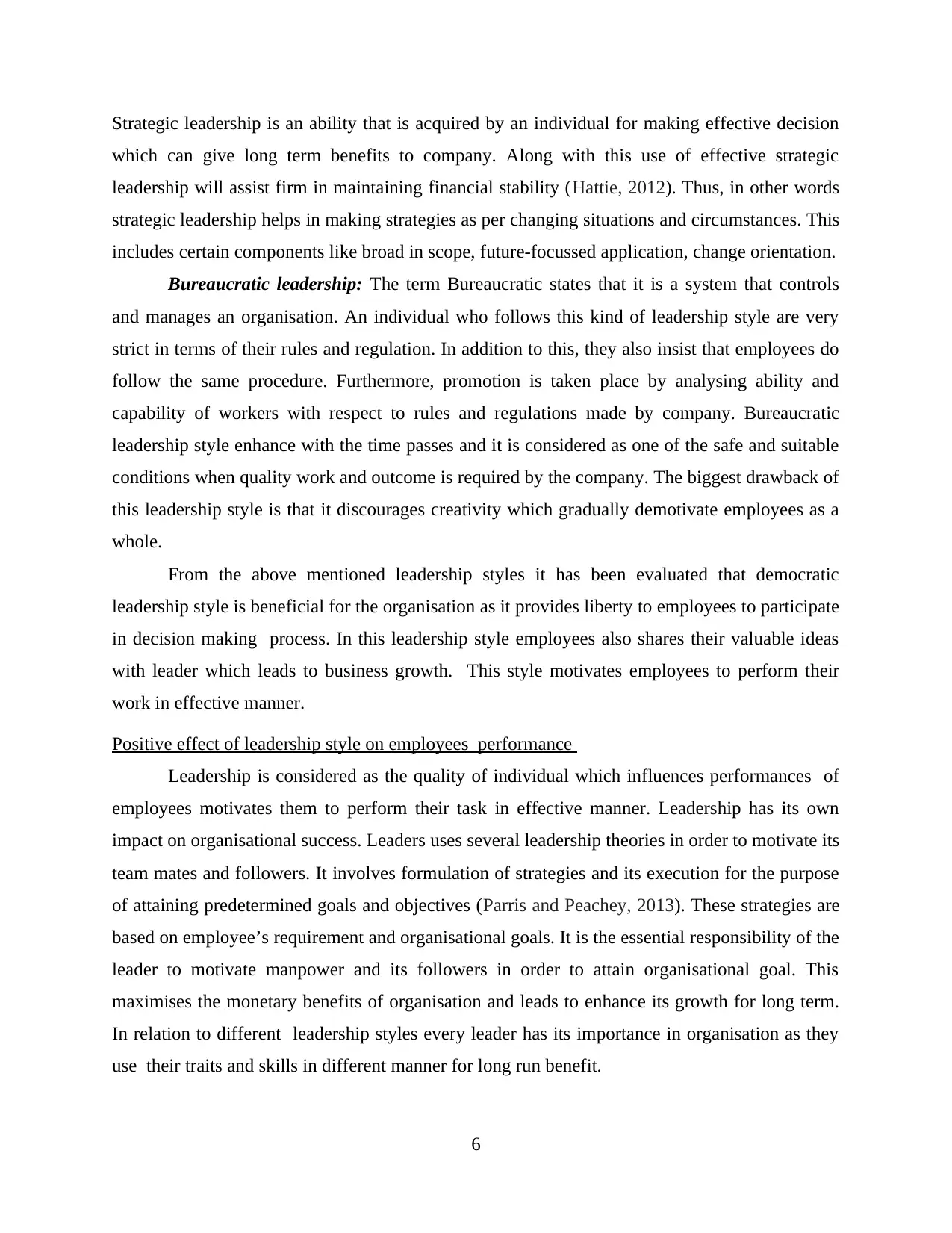
Strategic leadership is an ability that is acquired by an individual for making effective decision
which can give long term benefits to company. Along with this use of effective strategic
leadership will assist firm in maintaining financial stability (Hattie, 2012). Thus, in other words
strategic leadership helps in making strategies as per changing situations and circumstances. This
includes certain components like broad in scope, future-focussed application, change orientation.
Bureaucratic leadership: The term Bureaucratic states that it is a system that controls
and manages an organisation. An individual who follows this kind of leadership style are very
strict in terms of their rules and regulation. In addition to this, they also insist that employees do
follow the same procedure. Furthermore, promotion is taken place by analysing ability and
capability of workers with respect to rules and regulations made by company. Bureaucratic
leadership style enhance with the time passes and it is considered as one of the safe and suitable
conditions when quality work and outcome is required by the company. The biggest drawback of
this leadership style is that it discourages creativity which gradually demotivate employees as a
whole.
From the above mentioned leadership styles it has been evaluated that democratic
leadership style is beneficial for the organisation as it provides liberty to employees to participate
in decision making process. In this leadership style employees also shares their valuable ideas
with leader which leads to business growth. This style motivates employees to perform their
work in effective manner.
Positive effect of leadership style on employees performance
Leadership is considered as the quality of individual which influences performances of
employees motivates them to perform their task in effective manner. Leadership has its own
impact on organisational success. Leaders uses several leadership theories in order to motivate its
team mates and followers. It involves formulation of strategies and its execution for the purpose
of attaining predetermined goals and objectives (Parris and Peachey, 2013). These strategies are
based on employee’s requirement and organisational goals. It is the essential responsibility of the
leader to motivate manpower and its followers in order to attain organisational goal. This
maximises the monetary benefits of organisation and leads to enhance its growth for long term.
In relation to different leadership styles every leader has its importance in organisation as they
use their traits and skills in different manner for long run benefit.
6
which can give long term benefits to company. Along with this use of effective strategic
leadership will assist firm in maintaining financial stability (Hattie, 2012). Thus, in other words
strategic leadership helps in making strategies as per changing situations and circumstances. This
includes certain components like broad in scope, future-focussed application, change orientation.
Bureaucratic leadership: The term Bureaucratic states that it is a system that controls
and manages an organisation. An individual who follows this kind of leadership style are very
strict in terms of their rules and regulation. In addition to this, they also insist that employees do
follow the same procedure. Furthermore, promotion is taken place by analysing ability and
capability of workers with respect to rules and regulations made by company. Bureaucratic
leadership style enhance with the time passes and it is considered as one of the safe and suitable
conditions when quality work and outcome is required by the company. The biggest drawback of
this leadership style is that it discourages creativity which gradually demotivate employees as a
whole.
From the above mentioned leadership styles it has been evaluated that democratic
leadership style is beneficial for the organisation as it provides liberty to employees to participate
in decision making process. In this leadership style employees also shares their valuable ideas
with leader which leads to business growth. This style motivates employees to perform their
work in effective manner.
Positive effect of leadership style on employees performance
Leadership is considered as the quality of individual which influences performances of
employees motivates them to perform their task in effective manner. Leadership has its own
impact on organisational success. Leaders uses several leadership theories in order to motivate its
team mates and followers. It involves formulation of strategies and its execution for the purpose
of attaining predetermined goals and objectives (Parris and Peachey, 2013). These strategies are
based on employee’s requirement and organisational goals. It is the essential responsibility of the
leader to motivate manpower and its followers in order to attain organisational goal. This
maximises the monetary benefits of organisation and leads to enhance its growth for long term.
In relation to different leadership styles every leader has its importance in organisation as they
use their traits and skills in different manner for long run benefit.
6
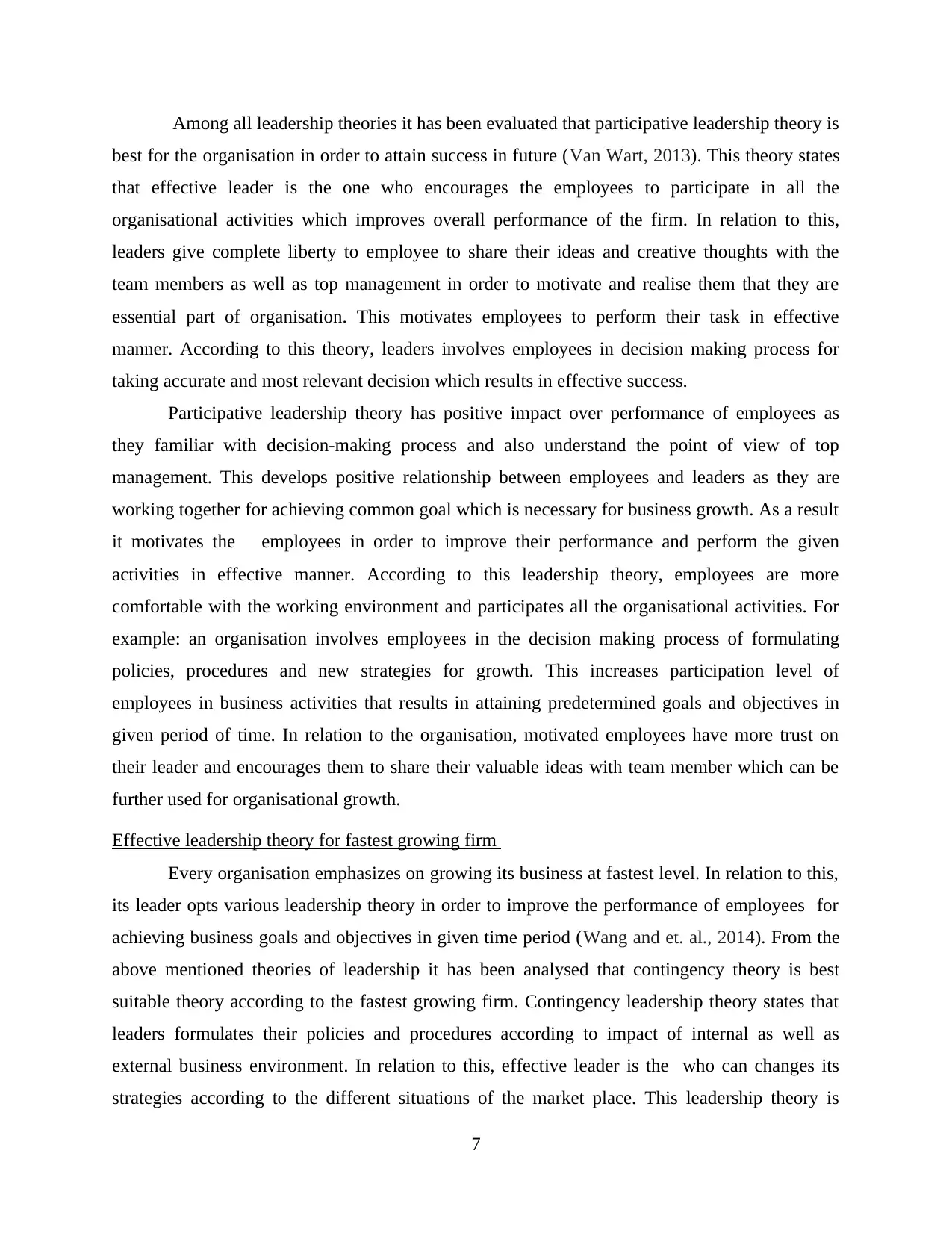
Among all leadership theories it has been evaluated that participative leadership theory is
best for the organisation in order to attain success in future (Van Wart, 2013). This theory states
that effective leader is the one who encourages the employees to participate in all the
organisational activities which improves overall performance of the firm. In relation to this,
leaders give complete liberty to employee to share their ideas and creative thoughts with the
team members as well as top management in order to motivate and realise them that they are
essential part of organisation. This motivates employees to perform their task in effective
manner. According to this theory, leaders involves employees in decision making process for
taking accurate and most relevant decision which results in effective success.
Participative leadership theory has positive impact over performance of employees as
they familiar with decision-making process and also understand the point of view of top
management. This develops positive relationship between employees and leaders as they are
working together for achieving common goal which is necessary for business growth. As a result
it motivates the employees in order to improve their performance and perform the given
activities in effective manner. According to this leadership theory, employees are more
comfortable with the working environment and participates all the organisational activities. For
example: an organisation involves employees in the decision making process of formulating
policies, procedures and new strategies for growth. This increases participation level of
employees in business activities that results in attaining predetermined goals and objectives in
given period of time. In relation to the organisation, motivated employees have more trust on
their leader and encourages them to share their valuable ideas with team member which can be
further used for organisational growth.
Effective leadership theory for fastest growing firm
Every organisation emphasizes on growing its business at fastest level. In relation to this,
its leader opts various leadership theory in order to improve the performance of employees for
achieving business goals and objectives in given time period (Wang and et. al., 2014). From the
above mentioned theories of leadership it has been analysed that contingency theory is best
suitable theory according to the fastest growing firm. Contingency leadership theory states that
leaders formulates their policies and procedures according to impact of internal as well as
external business environment. In relation to this, effective leader is the who can changes its
strategies according to the different situations of the market place. This leadership theory is
7
best for the organisation in order to attain success in future (Van Wart, 2013). This theory states
that effective leader is the one who encourages the employees to participate in all the
organisational activities which improves overall performance of the firm. In relation to this,
leaders give complete liberty to employee to share their ideas and creative thoughts with the
team members as well as top management in order to motivate and realise them that they are
essential part of organisation. This motivates employees to perform their task in effective
manner. According to this theory, leaders involves employees in decision making process for
taking accurate and most relevant decision which results in effective success.
Participative leadership theory has positive impact over performance of employees as
they familiar with decision-making process and also understand the point of view of top
management. This develops positive relationship between employees and leaders as they are
working together for achieving common goal which is necessary for business growth. As a result
it motivates the employees in order to improve their performance and perform the given
activities in effective manner. According to this leadership theory, employees are more
comfortable with the working environment and participates all the organisational activities. For
example: an organisation involves employees in the decision making process of formulating
policies, procedures and new strategies for growth. This increases participation level of
employees in business activities that results in attaining predetermined goals and objectives in
given period of time. In relation to the organisation, motivated employees have more trust on
their leader and encourages them to share their valuable ideas with team member which can be
further used for organisational growth.
Effective leadership theory for fastest growing firm
Every organisation emphasizes on growing its business at fastest level. In relation to this,
its leader opts various leadership theory in order to improve the performance of employees for
achieving business goals and objectives in given time period (Wang and et. al., 2014). From the
above mentioned theories of leadership it has been analysed that contingency theory is best
suitable theory according to the fastest growing firm. Contingency leadership theory states that
leaders formulates their policies and procedures according to impact of internal as well as
external business environment. In relation to this, effective leader is the who can changes its
strategies according to the different situations of the market place. This leadership theory is
7
⊘ This is a preview!⊘
Do you want full access?
Subscribe today to unlock all pages.

Trusted by 1+ million students worldwide
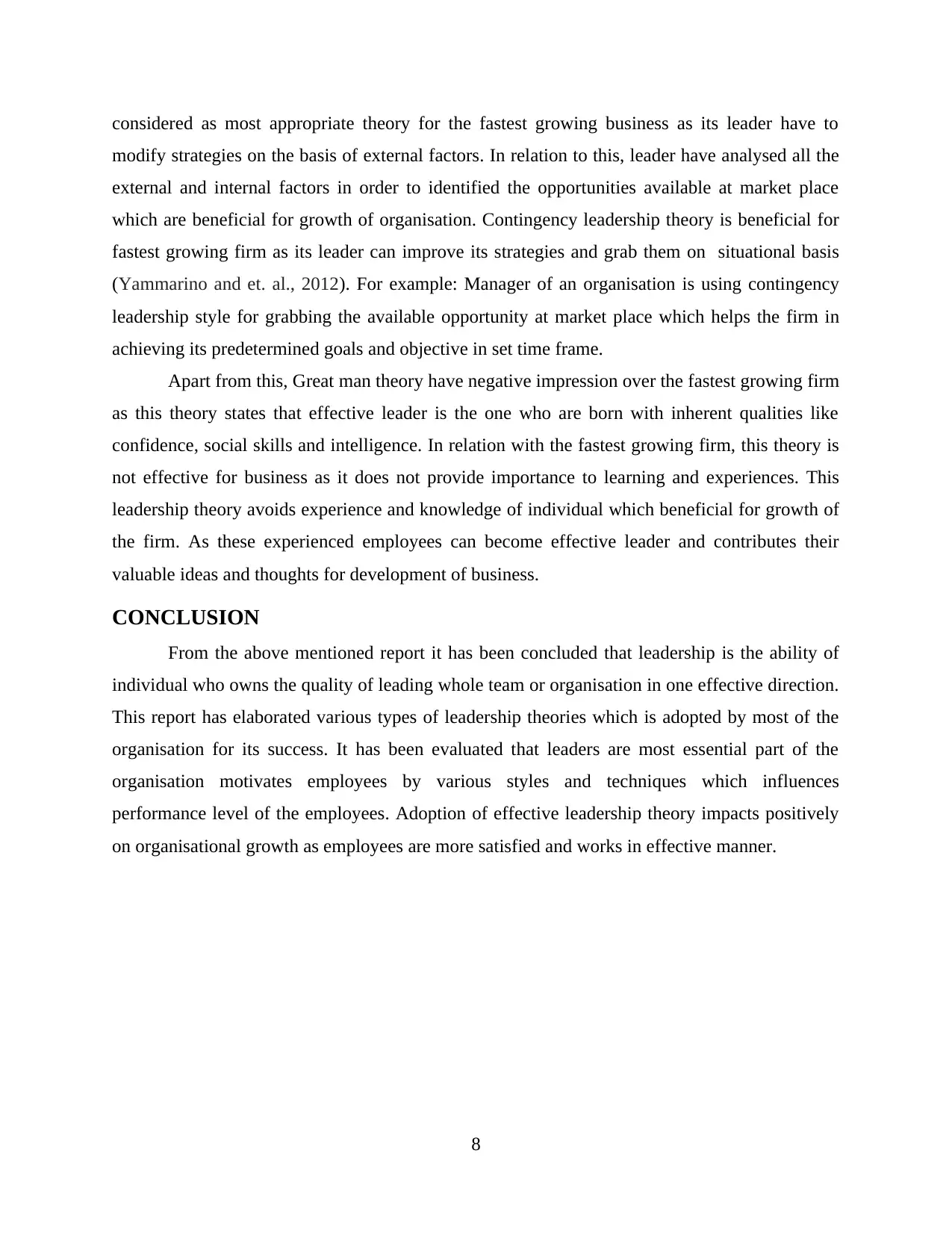
considered as most appropriate theory for the fastest growing business as its leader have to
modify strategies on the basis of external factors. In relation to this, leader have analysed all the
external and internal factors in order to identified the opportunities available at market place
which are beneficial for growth of organisation. Contingency leadership theory is beneficial for
fastest growing firm as its leader can improve its strategies and grab them on situational basis
(Yammarino and et. al., 2012). For example: Manager of an organisation is using contingency
leadership style for grabbing the available opportunity at market place which helps the firm in
achieving its predetermined goals and objective in set time frame.
Apart from this, Great man theory have negative impression over the fastest growing firm
as this theory states that effective leader is the one who are born with inherent qualities like
confidence, social skills and intelligence. In relation with the fastest growing firm, this theory is
not effective for business as it does not provide importance to learning and experiences. This
leadership theory avoids experience and knowledge of individual which beneficial for growth of
the firm. As these experienced employees can become effective leader and contributes their
valuable ideas and thoughts for development of business.
CONCLUSION
From the above mentioned report it has been concluded that leadership is the ability of
individual who owns the quality of leading whole team or organisation in one effective direction.
This report has elaborated various types of leadership theories which is adopted by most of the
organisation for its success. It has been evaluated that leaders are most essential part of the
organisation motivates employees by various styles and techniques which influences
performance level of the employees. Adoption of effective leadership theory impacts positively
on organisational growth as employees are more satisfied and works in effective manner.
8
modify strategies on the basis of external factors. In relation to this, leader have analysed all the
external and internal factors in order to identified the opportunities available at market place
which are beneficial for growth of organisation. Contingency leadership theory is beneficial for
fastest growing firm as its leader can improve its strategies and grab them on situational basis
(Yammarino and et. al., 2012). For example: Manager of an organisation is using contingency
leadership style for grabbing the available opportunity at market place which helps the firm in
achieving its predetermined goals and objective in set time frame.
Apart from this, Great man theory have negative impression over the fastest growing firm
as this theory states that effective leader is the one who are born with inherent qualities like
confidence, social skills and intelligence. In relation with the fastest growing firm, this theory is
not effective for business as it does not provide importance to learning and experiences. This
leadership theory avoids experience and knowledge of individual which beneficial for growth of
the firm. As these experienced employees can become effective leader and contributes their
valuable ideas and thoughts for development of business.
CONCLUSION
From the above mentioned report it has been concluded that leadership is the ability of
individual who owns the quality of leading whole team or organisation in one effective direction.
This report has elaborated various types of leadership theories which is adopted by most of the
organisation for its success. It has been evaluated that leaders are most essential part of the
organisation motivates employees by various styles and techniques which influences
performance level of the employees. Adoption of effective leadership theory impacts positively
on organisational growth as employees are more satisfied and works in effective manner.
8
Paraphrase This Document
Need a fresh take? Get an instant paraphrase of this document with our AI Paraphraser
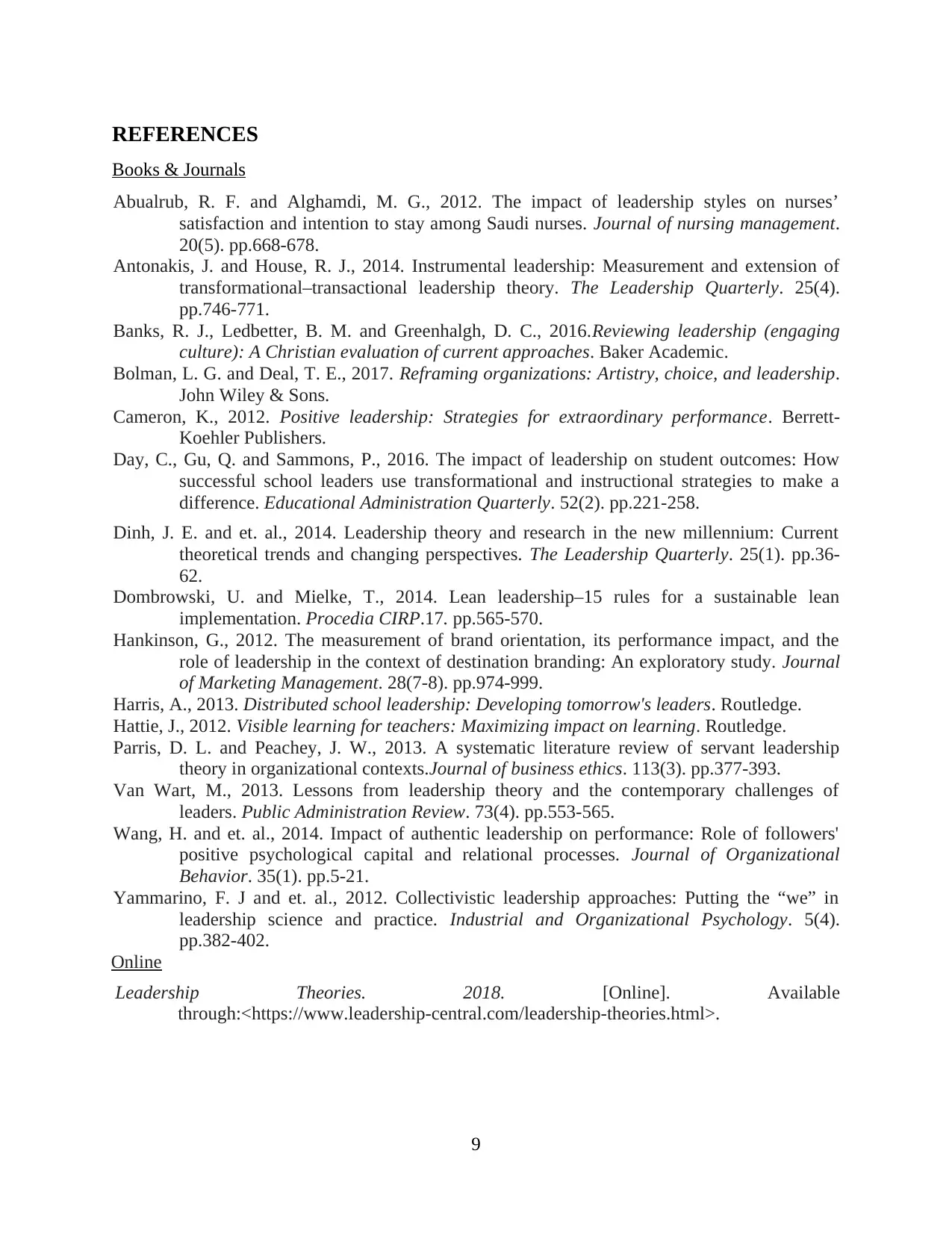
REFERENCES
Books & Journals
Abualrub, R. F. and Alghamdi, M. G., 2012. The impact of leadership styles on nurses’
satisfaction and intention to stay among Saudi nurses. Journal of nursing management.
20(5). pp.668-678.
Antonakis, J. and House, R. J., 2014. Instrumental leadership: Measurement and extension of
transformational–transactional leadership theory. The Leadership Quarterly. 25(4).
pp.746-771.
Banks, R. J., Ledbetter, B. M. and Greenhalgh, D. C., 2016.Reviewing leadership (engaging
culture): A Christian evaluation of current approaches. Baker Academic.
Bolman, L. G. and Deal, T. E., 2017. Reframing organizations: Artistry, choice, and leadership.
John Wiley & Sons.
Cameron, K., 2012. Positive leadership: Strategies for extraordinary performance. Berrett-
Koehler Publishers.
Day, C., Gu, Q. and Sammons, P., 2016. The impact of leadership on student outcomes: How
successful school leaders use transformational and instructional strategies to make a
difference. Educational Administration Quarterly. 52(2). pp.221-258.
Dinh, J. E. and et. al., 2014. Leadership theory and research in the new millennium: Current
theoretical trends and changing perspectives. The Leadership Quarterly. 25(1). pp.36-
62.
Dombrowski, U. and Mielke, T., 2014. Lean leadership–15 rules for a sustainable lean
implementation. Procedia CIRP.17. pp.565-570.
Hankinson, G., 2012. The measurement of brand orientation, its performance impact, and the
role of leadership in the context of destination branding: An exploratory study. Journal
of Marketing Management. 28(7-8). pp.974-999.
Harris, A., 2013. Distributed school leadership: Developing tomorrow's leaders. Routledge.
Hattie, J., 2012. Visible learning for teachers: Maximizing impact on learning. Routledge.
Parris, D. L. and Peachey, J. W., 2013. A systematic literature review of servant leadership
theory in organizational contexts.Journal of business ethics. 113(3). pp.377-393.
Van Wart, M., 2013. Lessons from leadership theory and the contemporary challenges of
leaders. Public Administration Review. 73(4). pp.553-565.
Wang, H. and et. al., 2014. Impact of authentic leadership on performance: Role of followers'
positive psychological capital and relational processes. Journal of Organizational
Behavior. 35(1). pp.5-21.
Yammarino, F. J and et. al., 2012. Collectivistic leadership approaches: Putting the “we” in
leadership science and practice. Industrial and Organizational Psychology. 5(4).
pp.382-402.
Online
Leadership Theories. 2018. [Online]. Available
through:<https://www.leadership-central.com/leadership-theories.html>.
9
Books & Journals
Abualrub, R. F. and Alghamdi, M. G., 2012. The impact of leadership styles on nurses’
satisfaction and intention to stay among Saudi nurses. Journal of nursing management.
20(5). pp.668-678.
Antonakis, J. and House, R. J., 2014. Instrumental leadership: Measurement and extension of
transformational–transactional leadership theory. The Leadership Quarterly. 25(4).
pp.746-771.
Banks, R. J., Ledbetter, B. M. and Greenhalgh, D. C., 2016.Reviewing leadership (engaging
culture): A Christian evaluation of current approaches. Baker Academic.
Bolman, L. G. and Deal, T. E., 2017. Reframing organizations: Artistry, choice, and leadership.
John Wiley & Sons.
Cameron, K., 2012. Positive leadership: Strategies for extraordinary performance. Berrett-
Koehler Publishers.
Day, C., Gu, Q. and Sammons, P., 2016. The impact of leadership on student outcomes: How
successful school leaders use transformational and instructional strategies to make a
difference. Educational Administration Quarterly. 52(2). pp.221-258.
Dinh, J. E. and et. al., 2014. Leadership theory and research in the new millennium: Current
theoretical trends and changing perspectives. The Leadership Quarterly. 25(1). pp.36-
62.
Dombrowski, U. and Mielke, T., 2014. Lean leadership–15 rules for a sustainable lean
implementation. Procedia CIRP.17. pp.565-570.
Hankinson, G., 2012. The measurement of brand orientation, its performance impact, and the
role of leadership in the context of destination branding: An exploratory study. Journal
of Marketing Management. 28(7-8). pp.974-999.
Harris, A., 2013. Distributed school leadership: Developing tomorrow's leaders. Routledge.
Hattie, J., 2012. Visible learning for teachers: Maximizing impact on learning. Routledge.
Parris, D. L. and Peachey, J. W., 2013. A systematic literature review of servant leadership
theory in organizational contexts.Journal of business ethics. 113(3). pp.377-393.
Van Wart, M., 2013. Lessons from leadership theory and the contemporary challenges of
leaders. Public Administration Review. 73(4). pp.553-565.
Wang, H. and et. al., 2014. Impact of authentic leadership on performance: Role of followers'
positive psychological capital and relational processes. Journal of Organizational
Behavior. 35(1). pp.5-21.
Yammarino, F. J and et. al., 2012. Collectivistic leadership approaches: Putting the “we” in
leadership science and practice. Industrial and Organizational Psychology. 5(4).
pp.382-402.
Online
Leadership Theories. 2018. [Online]. Available
through:<https://www.leadership-central.com/leadership-theories.html>.
9
1 out of 11
Related Documents
Your All-in-One AI-Powered Toolkit for Academic Success.
+13062052269
info@desklib.com
Available 24*7 on WhatsApp / Email
![[object Object]](/_next/static/media/star-bottom.7253800d.svg)
Unlock your academic potential
Copyright © 2020–2025 A2Z Services. All Rights Reserved. Developed and managed by ZUCOL.





